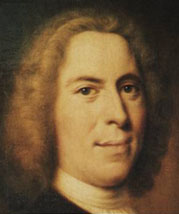Christian Thought From the Eighteenth to the Twentieth Century/Pietism in Germany
- "For Zinzendorf, Pietism's attempt to foster holiness would be served best by persons absolutely committed to that end—persons set apart for the sake of the larger church and society. In this sense, as Peter Zimmerling notes, the Moravian Pietists were very much like the monastics of the Middle Ages: both were 'revivalist movements' that sought to get 'the established church into motion'".
- (Christopher Barnett in: Kierkegaard, Pietism and Holiness)
- "For Zinzendorf, Pietism's attempt to foster holiness would be served best by persons absolutely committed to that end—persons set apart for the sake of the larger church and society. In this sense, as Peter Zimmerling notes, the Moravian Pietists were very much like the monastics of the Middle Ages: both were 'revivalist movements' that sought to get 'the established church into motion'".
When continental Lutheran and Calvinist reformers of the seventeenth century fostered a more theology and dogma oriented Christian life, Pietists responded with a call to personal sometimes even mystic experience of Christian life. As we can observe half a century later in European Romanticism, the Pietist movement broke new ground in regard to radical globalism of Christian existence (missions), and also in radically including gender and generation specific aspects of Christian life, like sexuality, childhood, marriage, aging (gerontology) as expressively spiritual exercises.
As a courageously outgoing and in many cases populist movement Pietists broke centuries old taboos. That had consequences for European societies as a whole. A certain amount of social responsibility for the weak and unprivileged as part of each citizen's conscience was a Pietist demand that partly influenced the later manifestation of the Romanticist democratic movement in Europe.
- How would you describe the relation of major Pietist representatives to rationalist and liberal contemporaries?
- According to Zimmerling, where do you see parallels or similarities between Medieval monasticism and the eighteenth century Pietism?
- Were there interrelations between German Romanticism and Pietism, and if yes, how did they look like?
- What is the intersection of Pietism with Anabaptism, within and without the Schwarzenau Brethren?
To get the bigger picture we want to study several short overviews and then some representatives of German speaking Pietists of the eighteenth century.
Please go to all of the below web sites and study each of these essays extensively. Make notes while you read. You will need your notes later to edit and/or re-write already existing WP stubs. Don't forget to collect exact sources for your information. Any essential knowledge needs to be buttressed with reliable source material (see the three links in your assignment below!).
- James Paulgaard: The Rise of German Pietism in the 17th Century
- Sassen: 18th Century German Philosophy (SEP)
- Peter Heltzel: Philipp Jakob Spener and the Rise of Pietism in Germany
- CE: Pietism
- F. Ernest Stoffler: German Pietism During the Eighteenth Century
- Jonathan Strom: Introduction: Pietism in Two Worlds
- Global Anabaptist Mennonite Encyclopedia Online: Pietism
- Ingrid Goggan Lelos: The Spirit in the Flesh: The Translation of German Pietist Imagery into Anglo-American Cultures
- Ranald Macaulay: The Pietistic Roots of Evangelicalism Today
- Fred van Lieburg and Daniel Lindmark, Ed.: Pietism, Revivalism and Modernity, 1650-1850
Add substantial source-verified info [1][2][3] to five WP stubs that are related to the unit's topic.
Each stub addition should have at least 600 words. Click here to submit the stub links.
From left to right: August Hermann Francke, Nikolaus Ludwig von Zinzendorf, Philipp Jacob Spener.


